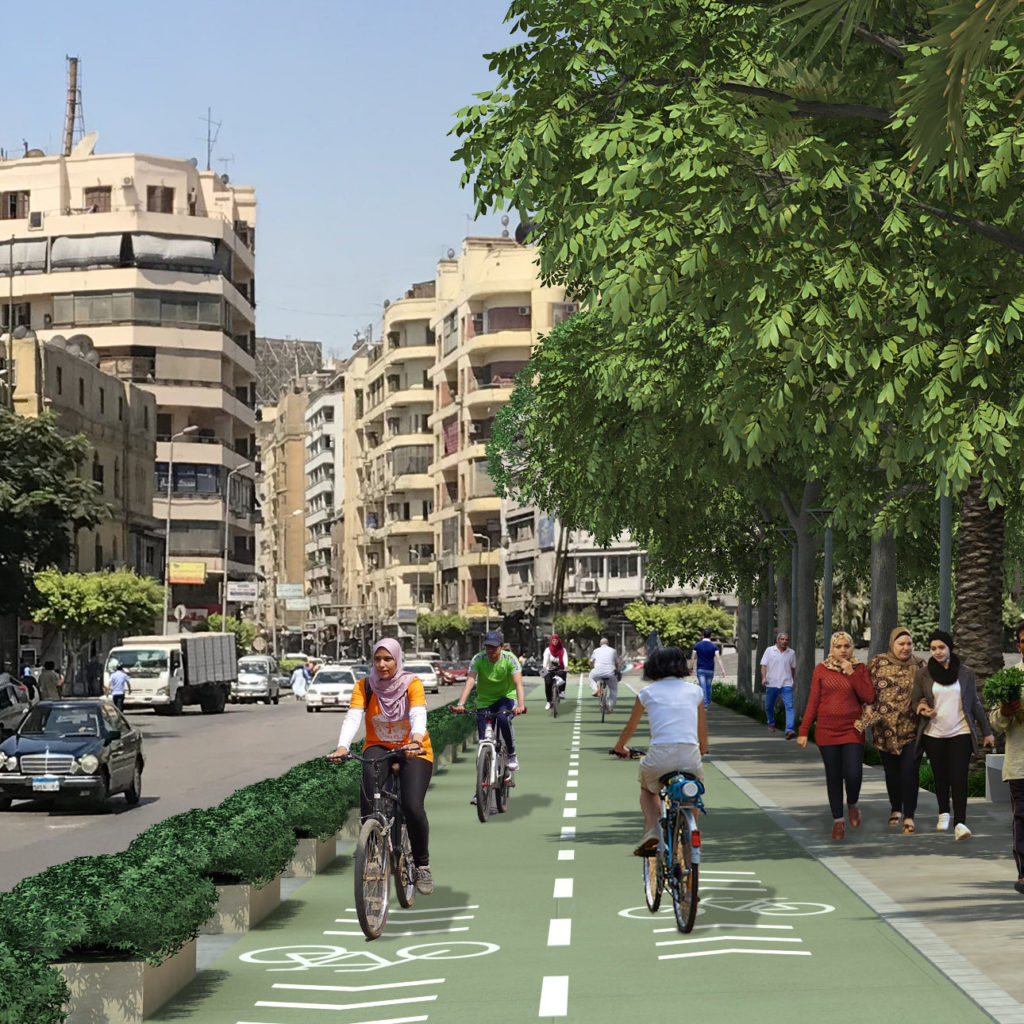 A rendering of ITDP’s proposed project in Cairo shows a new BRT corridor. This project is focused on improving commute conditions for women, who face greater obstacles in using public spaces.
A rendering of ITDP’s proposed project in Cairo shows a new BRT corridor. This project is focused on improving commute conditions for women, who face greater obstacles in using public spaces.
March 14, 2019
In Cairo, ITDP Works to Improve Transport Access for Women
Response from an anonymous ITDP
survey of women commuters in Cairo
“I leave home at 5:30 a.m. and arrive at 8 a.m. I take first a tok-tok for 5 EGP from the tunnel to Al -Khalafawy bus station. I wait 15 to 20 minutes for the bus to come. If the bus does not show up, I ride another taxi or bus until Al-methalat or Al-Sawah Station; and from there to the 10th of Ramadan and then to the Fifth Settlement. I repeat the same course while going home; either the bus is available or I have to go to the 10th of Ramadan and start the journey backward. The dangers for me consist in the cost, effort, and time wasted in transportation. The means of transport are so terribly crowded. When I arrive home, I am so tired that I cannot do anything anymore. I do not get tired from working, I am exhausted by the trip.”
All over the world, women build healthy, safe, and prosperous societies. Due to the many responsibilities that fall on them— caring for children, running a household, and paid work—women have different travel patterns than men. When neighborhoods lack resources, such as grocery stores and healthcare facilities, the responsibility falls on women to find solutions. Cities need gender-responsive policies to address women’s diverse mobility requirements and reduce their burden. Greater Cairo, a region of more than 20 million people, is one of the largest metropolitan areas in Africa. Like many megacities around the world, it is famous for its traffic congestion. A lack of rapid transit options and skyrocketing private car ownership has led to daily traffic snarls on the wide roads that crisscross the area. While these roads continue to be built, most of the population relies on public transport. The oldest and most organized mode of transport is the underground Metro.

The metro covers 78 km connected by three lines that transport two million passengers daily. The overcrowded system is planned to expand to six lines by 2033. Until recently, transport planning and operations in Cairo have taken a “one-size-fits-all” approach, assuming that men and women will benefit equally from improvements in transport services. In reality, women and men have different needs and expectations for the system, particularly with regards to safety. An integrated and safe public transport system provides access to education, work, health care, culture, and other important activities crucial to women’s participation in society. A 2013 UN Women study in Cairo found that the majority of female respondents reported that they did not feel secure or safe on the street.
Women also do not feel safe on public transport. As a result, they may forego trips or seek less efficient or more costly alternatives when they perceive a threat.

Responding to these issues, ITDP has joined with organizations such as the New Urban Communities Authority, the United Nations Human Settlements Programme, and the United Nations Entity for Gender Equality and the Empowerment of Women to plan a bus rapid transit (BRT) system in Greater Cairo. Key tasks include completing passenger demand assessment, corridor identification, service plans, infrastructure designs, and gender-sensitive analysis for the BRT corridor. To better understand the challenges faced by women using the transport system, ITDP conducted a series of surveys and focus groups with commuters in Cairo. The research included a women’s travel pattern survey with 2,500 respondents; public transport terminal surveys that asked 220 men and 225 women about their travel patterns; operator interviews; rate of occupancy and gender counts; physical assessment surveys; and a women’s focus group.
ITDP found that overcrowding, harassment, multiple transfers, long waits and travel times, high fares, and unsafe driving behaviours were issues of great concern to women reliant on public transportation. The solution is a BRT system that considers data-driven gender concerns when designing service plans and infrastructure. To this end, ITDP has proposed designated areas for women on each bus; seating for pregnant women, the elderly, people with disabilities, and adults with small children; cameras on BRT buses to monitor harassment and violence; and a complaint and redress system. Other recommendations include providing a sufficient BRT fleet to meet passenger demand and introducing an integrated electronic fare system to simplify transfers. ITDP has also suggested that all drivers and staff complete training on safety and mobility challenges. This includes customer service, sexual harassment, and sensitivity education. Additionally, increasing the number of women working in public transport would help to put female commuters at ease. The new BRT Western system would consist of a 42 km corridor connecting 6th of October City to Giza. The corridor will have a critical load of 6,400 passengers per hour each way and around 50 buses per hour along Faisal Street. Overall, the system will carry 126,000 passengers per day. The BRT Western corridor will significantly benefit city residents. In addition to time savings of at least 15 minutes per trip, the system has the potential to improve traffic by decreasing car use. The switch from polluting vehicles to high capacity BRT buses will cut air and noise pollution, leading to significant public health benefits. A well-designed BRT will significantly reduce road fatalities, especially for pedestrians, the most vulnerable road users. ITDP and partners are working to ensure that this is a BRT system that takes into account the needs of women, children, the elderly, and people with disabilities. For society to grow and thrive, women in Cairo and beyond must have convenient, affordable, and safe options to access their cities’ resources and opportunities.

